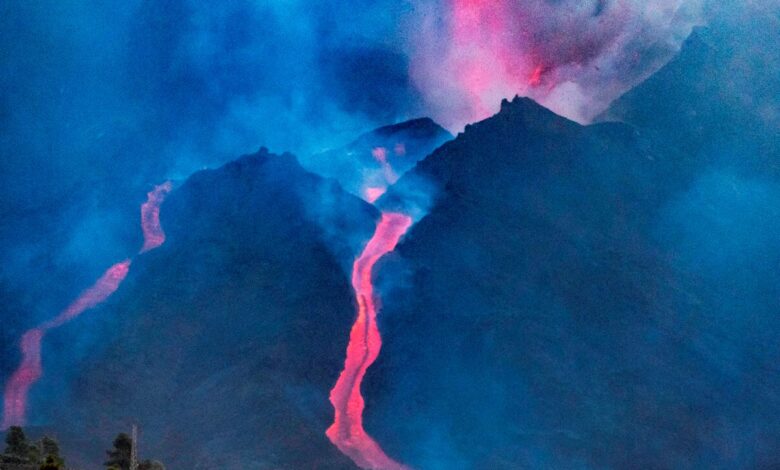Cumbre Vieja volcano in Spain celebrates three weeks in eruption and destruction


Lava from the Cumbre Vieja volcano covers more than 500 hectares within three weeks of its eruption.
Photo: Miguel Calero / EFE
Three weeks after waking up the volcano of Cumbre Vieja, on the Spanish island of La Palma, continues to generate new lava flows and eject gigantic blocks of volcanic material -some the size of a three-story building-, in an eruptive process that has increased in recent days as a result of the landslides. recorded in the crater area.
Since it erupted on September 19, the Cumbre Vieja volcano has already devastated an area of 525 hectares and 1,186 buildings destroyed, while 95 are at risk due to the path taken by the recent washings.
The new lava flow, with temperatures of up to 1,240 degrees Celsius, has destroyed the few buildings that remained standing north of the town of Todoque, one of the most affected, according to the Canary Islands Volcanological Institute (Involcan).
The experts assure that the evolution of the eruption continues within the normal process of a volcano while they continue to monitor their activity to ensure people’s safety.
The Cabildo (government) of La Palma explained today that evacuated neighbors with properties outside the security perimeter will be allowed to collect clothes and belongings, and for this access will be controlled and they will have the accompaniment of security personnel, prior coordination with your City Council.
The loud noise at night
The loud sound that the volcano emits when expelling the magma, together with the explosions and earthquakes, continues to accompany the residents of the surrounding areas, a situation that becomes especially harsh at night, like the last one.
Earthquakes are still abundant, but located between 10 and 15 kilometers deep, and even more than 20, so experts continue to fear that a new eruptive zone may open.
In the daily press conference offered by the specialists who work at the Cumbre Vieja, today they offered estimates of the amount of magma released by the volcano in these three weeks, which varies between 39.6 million cubic meters, according to a calculation of the They involve from the diffuse emission of sulfur dioxide, and the 60 million cubic meters estimated by a satellite program.
This “dance of figures” gives an idea of the difficulty of calculating the volume of magma at this time, explained scientist María José Blanco.
A 3,500 meter column of ash and gases
Blanco also stressed that according to the wind weather forecast, tomorrow the ash cloud may again affect the operation of the La Palma airport, as well as those of other islands of the Canary archipelago such as Tenerife.
The column of ash and gases has reached a height of 3,500 meters and the delta that the lava is forming as it falls into the sea continues to extend its surface and advance into the depth of the ocean.
The experts also monitor this terrain, which runs the risk of collapsing if it continues its advance to greater depths in the ocean, which would be accompanied by the sudden release of gases, with explosions and waves, although of low altitude.
The volcano emits 4,522 tons of sulfur dioxide and 1,958 tons of carbon dioxide per day, which according to scientists does not represent any risk for residents or visitors to the island.
La Cumbre Vieja is one of the most active volcanic complexes in the Canary Islands. There have been two of the last three eruptions recorded in the islands, the San Juan volcano, in 1949, and the Teneguía, in 1971, which caused a victim by inhalation of gases.
La Palma, like the rest of the Canary Islands, is an island of volcanic origin. With an estimated geological age of two million years, it is one of the youngest in the archipelago.
It may interest you:
· The lava from the La Palma volcano that has already reached the sea causes concern about the emission of harmful gases
· Cuba warns of the arrival of dust from the Sahara and ashes from the La Palma volcano
· Kilauea volcano alert level drops to orange in Hawaii
.



